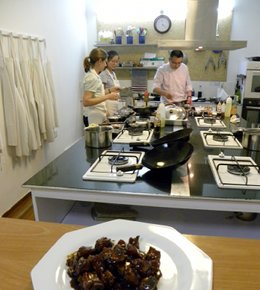 Just like America, China has a cooking problem. People are busy, mothers are busy.
Just like America, China has a cooking problem. People are busy, mothers are busy.
Restaurants and street food are everywhere, so people are cooking less and eating out more.
“Lots of young people don’t know how to cook,” says Miranda Yao, the owner of The Kitchen at Cooking Studio, a private cooking school in Shanghai. They cater to Americans living in Shanghai, but also to lots of locals who live in the hip French Concession area.
I was in Shanghai on vacation and while I know how to cook and love to cook, my Chinese dishes never turn out quite right. Tasty, but not Chinese. I’d come to The Kitchen to learn from the source.
Ingredients
Chef Alan Wang started with the bottles in front of me. Through Yao, who speaks perfect English, he explained what they were: light soy sauce, which isn’t low-sodium; dark soy, used for color at the end of cooking; yellow rice wine, which is nothing like the rice wine sold in our supermarkets; dark rice wine; and rock sugar, which gives food a beautiful gloss.
So here was problem # 1: My ingredients were all wrong. The soy sauce and rice vinegar at home were supermarket versions of the real thing. The proper ingredients require a trip to an Asian market, but there are lots in the suburbs (highly recommend Super H Mart in Niles), so no need to go to Chinatown. Alan recommends Lee Kum Kee as a reliable brand.
Technique
Not everything in Chinese cooking is stir fried, but everything is perfectly cut to an exact size for the cooking method used. And they use a cleaver to do it. My ginger and lettuce stem didn’t really resemble Alan’s perfectly julienned pieces, but mine still tasted delish. As long as you follow the directions and chop your ingredients to the correct size, the perfect squareness won’t really matter.
What does matter is getting the oil hot enough. They use canola or soybean oil for frying and they get it hot. As in turn-on-the-vent-or-your-smoke-detector-will-go-off hot. And they use more oil than fat-phobic Americans. Which explained my problem #2: I don’t use enough oil and I don’t get it hot enough.
Sweet and Sour
The final difference? Most of their recipes included sugar, which shocked me.
“We don’t eat much sugar in our desserts,” explained Wang. “We eat it in our food, instead.”
And it made the food perfectly balanced. Not sweet, but the rock sugar added at the end gave the food a glaze of yum.
Check out the “What’s For Dinner” this week. It’s Sweet and Sour Pork Ribs, Shanghai-style, from The Kitchen at Cooking Studio. It earned a huge thumbs-up from my husband, who came at the end to taste my dishes, and it’s not hard to make— you just need the right ingredients.
